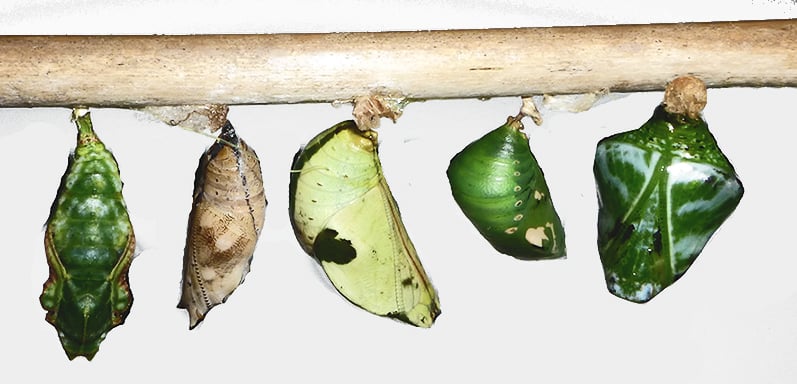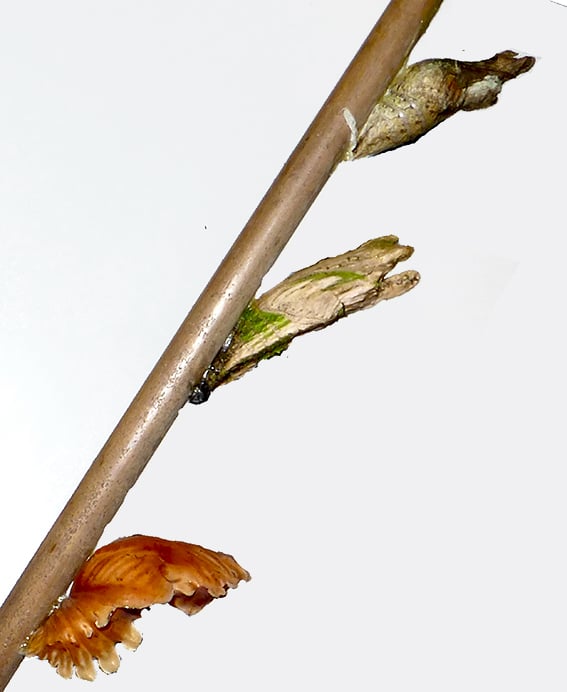EXOTIC BUTTERFLY PUPAE
It looks like you are ordering Internationally from United States, Please note below:
EXOTIC BUTTERFLY PUPAE
Most exotic pupae emerge quite quickly. For international orders, post takes too long, so fast-developing pupae are sent by XXP Express courier. Delivery in Europe is usually next day after dispatch, or soon after. Express courier usually delivers everything very fresh and in the peak of condition.

Exotic Butterfly Pupae Incredible shapes, colours, markings, knobs, metallic reflections. Such diversity only nature could invent.
The pupae are as different and exciting as the wonderful butterflies they produce.
IMPORTANT - Please read this guide to hatching of exotic butterfly pupae:
Provide warmth and humidity that the pupae normally experience in the tropics. About 30°C is ideal, and humidity above 70%. The butterflies like a warm greenhouse containing varied plants, especially those producing nectar flowers to feed from, and this is the best place also for the emerging cage for the pupae. Examples of nectar flowers include Ixora, Buddleia, Pentas, Eupatorum, Clerodendrum and most Asteraceae (formerly Compositae). Shade the cage from direct sun, which is too harsh. If you don’t have such an environment, you may be able to simulate a warm and humid atmosphere in another way, but don’t apply direct heat. The whole incubation cage needs to be in an even temperature and humidity, which is best provided in a tropical greenhouse environment. It is usually beneficial to mist the pupae at several times a day. It is normal in nature for night to be cooler than day.
It’s a good idea to suspend the pupae. To do this, use a cane held horizontally. Apply a very thin line of contact adhesive eg Evostick along the cane. Lay the cane on a table and, when it is tacky but not yet set hard, touch the tails of the pupae on the line of glue. Warning: excess glue actually kills the pupa, so use just a very thin line. When the glue has set you can pick up the cane, with all the pupae hanging by their tails from it.

Pupae of the Swallowtail and Pierid families don’t hang from the tail (cremaster), head downwards. They are attached to a twig at the tail, and they use a silk sling around the wing cases to anchor themselves, head upwards and at an angle away from the twig. To simulate this, you can take some lengths of cane. Make a thin line of glue as described above. Lay the cane on a table, then attach the tails of the pupae to the glue line, and touch the abdomen also against the glue line. Once dry, the cane can be arranged standing at an angle against the sides of the emerging cage, or you can arrange them stuck into a block of florist’s foam. There needs to be enough space to allow the emerging butterflies to climb up, expand and dry their wings.

Usually fixing the pupae to a cane helps to give hatching butterflies the best foothold. When fixed to canes pupae are very exposed and can easily dry out. Mist them several times a day. If you don’t wish to glue the pupae to a cane, they can be laid out on corrugated card or other rough surfaces, such as bobble foam, flat on the bottom of the emerging cage. See PUPAE NEST on this website. This material will help to keep the pupae moist if you spray them at least once a day. For hygiene the material needs to be cleaned or replaced every few days.
Resulting butterflies do well in a tropical greenhouse, planted with lush greenery and copious nectar-bearing flowers. Some species like to feed from over-ripe fruit. They may live 2-4 weeks in such conditions, exceptionally they can live longer. Kept in a cage in a house, their life may be just a few days, but sometimes longer if they are given fresh nectar flowers each day, and misted to prevent the atmosphere becoming too dry. Non-native butterflies must not be released.
